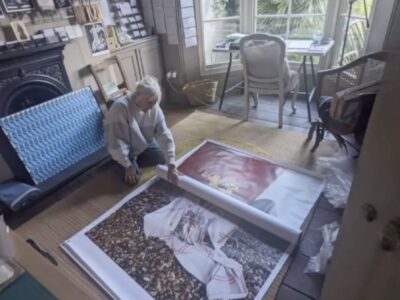The myth of the solitary creative
For most of human existence, we needed a tribe to survive. If you were cast out, it meant almost certain death. Which is why we still feel an almost primal sense of panic and unease, if we feel disliked or left out.
We’re no longer prey to wild beasts, of course. And most of us buy our food from supermarkets instead of hunting it in teams or growing it as a community. So we can get by alone. But it’s lonely, and it’s hard.
We can survive. But to truly thrive, we need connection. We need each other. Creatives as much as anyone – and perhaps even more so.
History tends to get written in terms of ‘great men’.
It simplifies the narrative if we focus on genius figures who make great leaps in human understanding. Portraying them as toiling alone and misunderstood makes them even more heroic.
There is a persuasive myth of the lone genius writing in a garret, painting alone in a field, running experiments in isolation, leaping out of the bath-tub and yelling “Eureka!”
But dig deeper, and you’ll find that’s rarely true. Culture isn’t created by outliers. Most new movements and leaps forward in culture usually come from groups of creatives encouraging each other; competing with and arguing with each other; reacting for or against each others’ work.
The tortured artist is a seductive idea.
Vincent Van Gogh is perhaps now the archetype of the misunderstood artist, working alone and unappreciated. In fact, he had constant financial and emotional support from his brother Theo, a successful art dealer. And he was embraced by the Impressionists as one of their own, his work appearing in their then-controversial exhibitions. (He in turn connected them to Theo, who helped them sell their work.)
Vincent died at the age of 37, his brother only a few years after. But in his book Real Artists Don’t Starve, Jeff Goins points out that Theo’s wife Johanna was then left with a house full of Vincent’s work, And the art world connections to sell them.
She edited and published the brothers’ letters to each other, and later oversaw their translation into English. Would we know about Van Gogh now without her network, and her willingness to grow his reputation?
Brian Eno, and collective genius
Brian Eno is a musician and producer who launched his career in Roxy Music, invented the whole genre of ambient electronic music, then went on to produce artists like David Bowie and Devo, U2 and Coldplay. A product of the innovative British art school scene in the late 60s/early 70s, Eno coined a new word to describe creatives working together to form a scene.
“Like all art students, I was encouraged to believe that there were a few great figures like Picasso and Kandinsky, Rembrandt and Giotto and so on who sort-of appeared out of nowhere and produced artistic revolution,” he explains.
“As I looked at art more and more, I discovered that that wasn’t really a true picture. What really happened was that there were sometimes very fertile scenes involving lots and lots of people – some of them artists, some of them collectors, some of them curators, thinkers, theorists, people who were fashionable and knew what the hip things were – all sorts of people who created a kind of ecology of talent. And out of that ecology arose some wonderful work.
“So I came up with this word ‘scenius’ – the intelligence of a whole operation or group of people. I think that’s a more useful way to think about culture. Let’s forget the idea of ‘genius’ for a little while, let’s think about the whole ecology of ideas that give rise to good new thoughts and good new work.”
How scenius grows
Amplifying on this idea later in Wired magazine, Kevin Kelly suggests that a fertile scenius emerges from at least some of the following conditions:
- Mutual appreciation. Risky moves are applauded by the group, subtlety is appreciated, and friendly competition goads the shy. Scenius as the best kind of peer pressure.
- Rapid exchange of tools and techniques. As something is invented, it is shown off, then shared. Ideas flow quickly because they are flowing inside a common language and sensibility.
- Success is contagious. When a record is broken, a hit happens, or breakthrough erupts, the success is claimed by the entire scene. This empowers the scene to further success.
- Local tolerance for the new. The local “outside” does not push back too hard against the transgressions of the scene. Renegades and mavericks are protected by this buffer zone.
Scenius in action: New York and Manchester
In her wonderful memoir Just Kids, Patti Smith writes brilliantly of her friendship with artist Robert Mapplethorpe. She describes how they both came of age as creatives in late 70s New York, mixing with poets, authors, artists, musicians and playwrights in a fertile scene centred around the Chelsea Hotel.
Both were shaped by this scenius. Smith started setting her poetry to music for live readings, then almost by accident became a rock star. The memorable cover image on her 1975 breakthrough album Horses was, of course, taken by Mapplethorpe. I was one of many young women entranced and changed by Smith’s music but also by that proud, defiant, androgynous cover image.
When the Sex Pistols played at the Free Trade Hall in Manchester, they unwittingly triggered a scene that spawned bands like Buzzcocks, Magazine and Joy Division. That in turn inspired the fertile ‘Madchester’ club/music scene in 1990, which itself gave birth to Oasis.
This all came with a supporting cast of brilliant graphic designers, DJs, club promoters, venues, record stores, indie labels, studios, writers, fashion brands, blaggers, producers, drug dealers, dancers. Plus TV presenter/Factory records boss Tony Wilson as ringmaster to the whole circus. Would any of them have been as inspired if they’d been working in isolation?
Birmingham, Coventry and 2-Tone
I grew up in the middle of another cultural flashpoint. In the late 70s/early 80s, my home city of Birmingham was home to a thriving music scene that included the Au Pairs, The Beat, Dexy’s Midnight Runners, Steel Pulse and UB40.
The Specials, The Selector and the 2 Tone label were just down the road in Coventry, and part of our network. Then local New Romantic bands like Duran Duran reacted against what they saw as our post-punk, political earnestness.
There was also a support system of veteran Jamaican musicians promoting gigs, teaching music, and sharing their experience of building small record labels. There were reggae sound systems with connections across the UK. And an active branch of Rock Against Racism promoting gigs and events, and building links with like-minded bands from Leeds and London.
There was an edgy clothes market which forged connections with emerging fashion designers in London’s Kensington Market. Local papers and fanzines publicised the scene, and community arts organisations offered their facilities to make gig posters and fanzines. Everyone pitched in and did what they could.
My own contribution was writing: reviews for local radio, my own fanzine, articles for local and national Rock Against Racism publications. I doubt I’d have broken into the London media without the momentum and support the Birmingham scenius gave me.
Culture shifts constantly, finding new networks, new flashpoints
And smart, ambitious young creatives are attracted by vibrant scenes, making them even bigger. Silicon Valley gave us the personal computer and the tech giants of today; but tomorrow’s innovations are far more likely to come from Austin, Texas.
Property is cheaper there (though it’s rising fast). There’s a lively music and bar scene, and the annual South By South-West festival. And its hip vibe is suddenly attracting the brightest tech graduates from all over the world.
Artists gather in clusters. Paris in the 1920s, New York in the early 60s, East London in the 90s, Berlin after that. In the 2020s, it seems to be moving out of big cities – a process hastened by the pandemic. Artists are moving out to smaller towns and communities, where living costs are lower. And forming new supportive cultural hubs in British towns such as Dundee, Hastings and Margate.
No access to a scenius? Then make one!
If you can’t uproot and move where the action is, create community around you – online or off. Seek out like-minded souls. Encourage other creatives. Reach out, and find your tribe.
Musician/performer Amanda Palmer is a shining example of what can happen if you communicate directly with your fans and ask for help. She famously crowd-funded the recording of her 2012 album Theatre Is Evil on Kickstarter, raising over $1 million.
See her brilliant TED talk, read her book The Art of Asking. Or just check out her Patreon page to find out more. She runs it brilliantly, offering all kinds of content, special access at concerts. She even records songs especially for her patrons, asking them to vote on what they want to hear.
In exchange, they pay $1-250 per month to support her work. As I write this, she has almost 10,000 patrons. You do the maths. Whatever the exact total, that adds up to huge artistic freedom.
Find the others
Look for people who are like you, and join them! Share your work with them, contacts or technical advice. Help and support each other: it’s how strangers become friends.
- Join your trade association – and show up to events with the secret mission of making a new friend/ally every time
- If you’re in a minority in your field, there might be a group for that, too. If not, consider creating one! It’s so refreshing not to have to explain your race, language, gender, sexuality, disability, neurodiversity or whatever else makes you feel different, and to hang out with others who understand your industry – and the challenges you might face.
- Get my free weekly newsletter! It shares resources, tips, thoughts about creative process – and hopefully makes creative work feel less lonely. Sign up for it here.
- Think of anywhere your people might hang out: writers groups, life-drawing classes, craft fairs, art sales, a relevant talk/event.
- Join as many online groups/forums as you can, and contribute to the chat there. You’ll soon know if they feel aligned to you, and if you want to stay.






I coach at some of the sessions for gold members of the London Writers Salon, but more importantly I use their daily Writers Hour sessions to keep me on track. It’s so lovely to be in a (virtual) room with so many other writers!
I love Brian Eno, and his term “Scenious”. I have a writing workshop online that started during the pandemic and still continues. We’ve lost some in the group and gained some new ones – four of us are from the beginning. I have broken through writer’s block and plot stuck-ness many times in that workshop.
Finding London Writers Salon has been life-changing, as well. Community is so important.